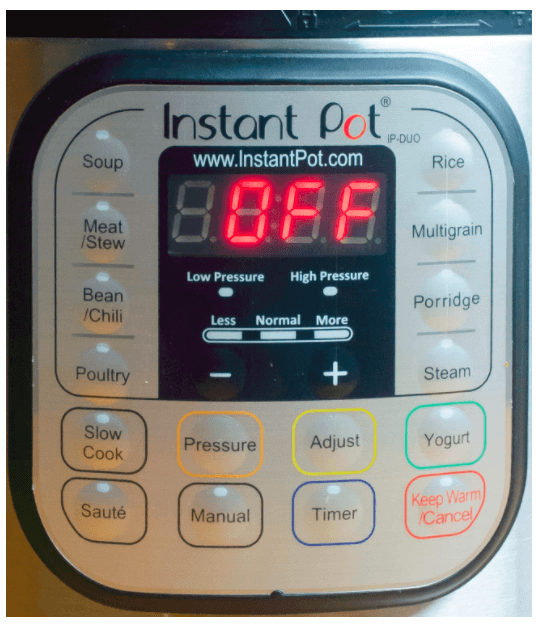Operational Buttons
Keep Warm/Cancel
After the cooking time has completed, the pot will automatically switch to “Keep Warm” mode, and will stay that way up to 10 hours. The digital display will count up so you can keep track of how long the food has been warming. You can manually set the Instant Pot to “Keep Warm” mode for up to 99 hours and 50 minutes. (Why you would need to keep something warm for 99 hours is beyond me… but if you have the need, it’s possible!)
You press this button to cancel out of a program or to turn the Instant Pot off. If you accidentally select a mode or need to reset and start over, you just hit the “Keep Warm/Cancel” button.

Pressure
Pressing this button allows you to switch from High Pressure to Low Pressure or vice versa. It doesn’t work in the slow cook, sauté, rice, or yogurt functions.
Adjust
This button allows you to adjust cooking times on the preset pressure cooker functions to “Less” or “More.” (“Less” and “More” are still preset cooking times, you can change by the minute in Manual mode.) You also use this button to change the temperature for Slow Cook and Sauté.
Timer
The timer allows you to delay your cooking start time. Very handy. It works with pressure cooking modes OR the slow cook mode, but you must select one of those options first. Within 10 seconds, press “Timer” and use the “+” or “-” buttons to set the delayed hours. Press “Timer” again to change the minutes.

Steam Valve
So, this is not a button, but it IS an important feature of your Instant Pot. This is where the pressure releases after cooking. There are only two things you can do here: toggle the valve to “Venting” or toggle the valve to “Sealing.” Before you start cooking anything, you want to make sure the valve is in the “Sealing” position, as shown in the picture. That allows the pressure to build up. When cooking is finished, the pressure needs to be released from the pot before you can open it. There are two ways for this to happen: natural release and quick release.

For natural release, you just leave the pot as is and don’t touch anything. The pressure will release on its own over time, usually about 10-20 minutes. You’ll know it’s done when the Floating Valve completely drops. (That’s the little silver circle to the right of the valve. You’ll hear a little click when it drops down.) Food continues cooking slowly during natural release, so keep that in mind when you’re adapting recipes.
For quick release, you just flip the valve to “Venting.” It’s a little alarming the first time you do it; the valve will immediately start hissing and releasing a cloud of steam, but that’s totally normal. You can use your bare hand to flip the valve (I always do), but if it makes you nervous, you can use an oven mitt or a wooden spoon or whatever you have lying around. It really only gets uncomfortably hot if you hold your hand directly over the steam though. This release only takes 1 to 2 minutes, and just as with the natural release, you’ll know it’s done when the Floating Valve drops down and the pot stops hissing. You want to use quick release for things like steamed vegetables or seafood that you want to be careful not to overcook.
I usually use a combo method, and let natural release work its magic for a few minutes before I flip it to quick release. If you’re making a recipe and know you want to use quick release to save time, you can always add a minute or two to the actual cooking time to be sure everything gets cooked completely.
On the next page, I’ll take you through the functions that make the Instant Pot so awesome, even though most of them don’t involve pressure cooking. (This includes my very, very favorite feature.) We’ll call them “Other” Cooking Buttons…
Continue to next page ……









